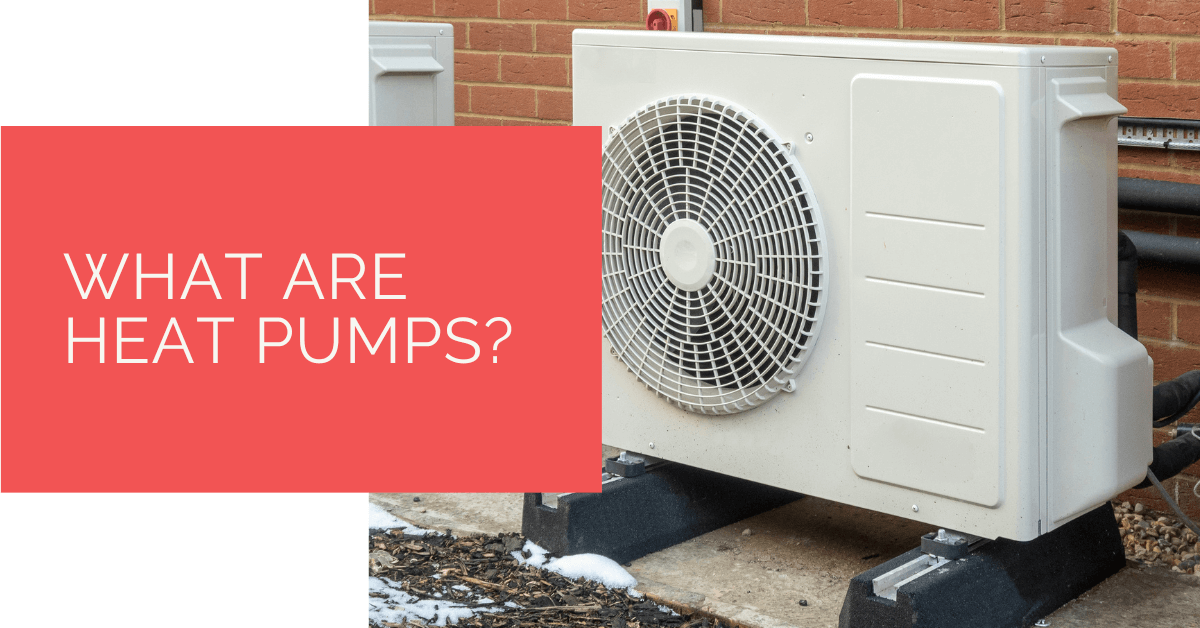In pursuing sustainable and energy-efficient home heating and cooling solutions, heat pumps have emerged as a modern marvel in the UK. These innovative devices have garnered increasing popularity due to their ability to provide warmth in winter and keep homes cool during summer. In this comprehensive article, we will delve into the world of heat pumps, exploring their diverse types, working principles, and the substantial benefits they offer homeowners and the environment.
A heat pump is a system that harnesses energy from the surrounding environment, be it the air, water, or ground, and transfers it into your home. This ingenious technology utilises compression, condensation, and absorption processes to provide efficient heating and cooling effects, making it a compelling alternative to traditional furnaces and air conditioners. As we venture deeper into the realm of heat pumps, we will discover their pivotal role in achieving the UK government’s ambitious 2050 Net Zero target, the various types available, and the cost-effective advantages they bring to households. Whether you’re seeking to reduce your carbon footprint, lower utility bills, or simply enjoy consistent and comfortable temperatures throughout the year, heat pumps may be the answer you’ve been searching for.
Contents
Key Takeaways
- Heat pumps are devices commonly found in UK households that provide heating in winter and cooling in summer with reduced running costs. They transfer heat using mechanical energy and refrigeration cycles.
- Installing home heat pumps can contribute to the UK government’s goal of reaching net-zero emissions by 2050. They are highly energy-efficient, have lower operating costs than boilers, and can source heat from the air, water, or ground.
- Different types of heat pumps are available in the UK, including geothermal, air source, and water source heat pumps, each with unique features and installation costs. These systems reduce carbon emissions, provide stable temperatures, and offer energy-efficient heating and cooling solutions.
The Definition of A Heat Pump
Technically, a heat pump in the UK is a device that heats water during winters and keeps your home cool during summers. Even though it is a new technology, its popularity has grown over the years. Hence, renewable heat pumps are abundant, especially the ones that work on solar energy.
Even the UK government educates the mass and requests residences to get heat pumps installed.
This system takes energy, cold, and heat from the air outside to transfer it into your home. Once done, this air gets circulated in the design, especially in a hot water storage unit. As mentioned earlier, these pumps are highly energy-efficient and could become an excellent alternative for furnaces or air conditioners.
Using a heat pump will amplify the temperature in your home. For example, it will make your cold space cooler while keeping your hot space warmer.
Similarly, the pumps move the hot air from the cooler outdoors to your warm house during the hot season. It can move heat from your home during winter to keep it warm. Hence, heat pumps are a versatile product that uses refrigeration to transfer heat instead of generating it.
When installing these devices, you should place them in an accessible area where general maintenance is easier. Overall, your home will have comfortable temperatures throughout the year.
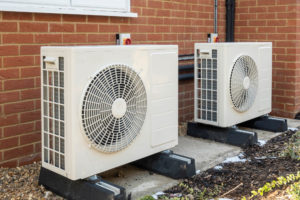
Should You Install a Heat Pump?
Heat pumps are crucial in helping the government achieve its ambitious goal of reaching Net Zero emissions by 2050. These devices offer a valuable contribution to this sustainability initiative, making them a worthy consideration for anyone looking to support this cause.
One of the significant advantages of heat pumps is their impressive efficiency. These systems outperform traditional boilers by a significant margin, with an efficiency rate ranging from 200% to 600%. This means that they require far less energy to operate than conventional heating methods, and ideally, the energy consumed is substantially less than the energy produced.
By installing heat pumps, you’re reducing carbon emissions on a domestic scale and contributing to national efforts to combat climate change. These devices offer a sustainable heating solution that benefits individual households and the environment.
Some heat pumps could source the heat from the soil in your garden and transfer it to a location like a heating system. Ideally, the heat pump should have components like:
- An outdoor unit consisting of coils and fans that facilitate heat exchange
- An indoor unit containing another set of fans and coils that allows the air to pass through
- The refrigerant liquid and the pressurising compressor
- The reversing and the expansion valve
With such pumps, transferring heat has become much more manageable. The rate of efficiency and reduced costs clearly explain the growing popularity of these devices. Moreover, these are great alternatives to using fossil fuels for heating or cooling purposes.
Installing these pumps will get you a reduced utility bill. Moreover, The Boiler Upgrade Scheme provides a direct grant to help cover the initial installation costs, making green heating technologies more accessible and affordable. For example, homeowners can receive grants of up to £7,500 for installing air source heat pumps and £6,000 for ground source heat pumps.
Note: Heat pumps could cool your home but will not work with radiators when installed as an underfloor system.
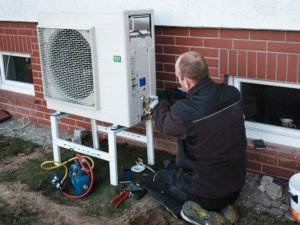
How Does the Heating Effect of A Heat Pump Work?
As you know, a heat pump transfers small amounts of thermal energy from the outside into your home. It takes out a higher temperature warmth or natural cools in the surrounding environment to provide heating or cooling effects in your home.
After the heat absorption, the device will directly feed it into your home while compressing it and allowing heat transference through coils.
Due to this heating system’s workability, you can compare these devices to a refrigerator. Here, a liquid’s cooling allows heat evaporation, lowering the temperature.
Heat pumps work well in moderate and everchanging climates of the UK. Besides, they can even work at temperatures as low as -20oC. Here are four basic steps that help a heat pump work.
1. Absorption
Before the process takes place, the system must first collect the heat. Depending on the heat pump you have in your home, it will either get absorbed from the air, water, or ground.
It uses a refrigerant that speeds up the absorption. This occurs inside the evaporator, where the refrigerant transfers from a liquid to a gas.
2. Compression
Once the refrigerant turns into a gas, it will start getting compressed to increase the temperature exponentially. So, you will get hot air circulated during the winter.
You can warm up your radiators, water, or more with this heat. The entire process gets reversed when the heat pump is in heating mode.
3. Condensation
Once the refrigerant has carried out the heating duties, it will turn back into a liquid. This condensation occurs in a different heat exchanger tube with such pumps.
This process is gradual and ensures a boost in efficiency. Why is that? Well, the hotness from the central heating system keeps on absorbing the temperature from the liquid refrigerant.
4. The Process Continues
After the refrigerant transfers to its liquid form, it goes through an expansion valve. This step only happens when the liquid cools down after the heating or cooling process is completed.
Once it enters the valve, the liquid decreases the pressure. Upon the release, the liquid goes back to the evaporator to begin the entire cycle again.
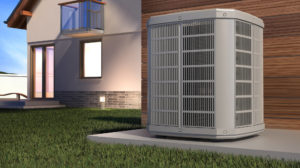
How Does the Cooling Mode of A Heat Pump Work?
Ironically, the cooling mode process is similar to the heating mode operations. However, the only difference is in the flow of refrigerant. This flow gets upturned into the reversing valve.
Due to the flow reversal, the heating source changes and becomes the air from the environment outside. Then, the energy gets released into the home, and the outside coil becomes the evaporator. At the same time, the indoor coil becomes the condenser.
Consequently, the outdoor unit absorbs heat energy. It then processes the liquid against the cold liquid refrigerant, turning it into a cold gas.
After the heating system applies pressure to this gas, it transforms into hot air. Moreover, this gas gets cooled down after passing through the indoor unit. After your home receives cold air or gas, condensation occurs. From a gas, it turns into a warm liquid which then relieves pressure to become harder.
From here, the renewing cycle continues to create cool air during the UK summers.
Different Types of Heat Pump
If you get heat pumps installed, you can extract thermal energy from potential places like outside air, water, or the ground. These are cleaner alternatives as they do not use fossil fuel to run.
In some devices, you could also find solar panels that further enhance the whole efficiency factor. Besides, did you know that the installation cost highly depends on the heat pump system? Well, listed below are the most common types of devices available in the UK.
Geothermal Heat Pump
Installation costs: Installation costs £10,000 for a 6kW pumps, £12,500 for an 8kW unit, and £17,500 for a 12kW system.
This device is a ground source heat pump system that transfers heat from the ground for your radiators. You can also use this transference of heat for underfloor heating purposes. Moreover, you can heat the water stored in your cylinder to access hot showers or tap water.
It is an excellent option for cooling and heating equally throughout your space. These ground source heat pumps concentrate on transferring natural heat into your home. You no longer have to worry about the combustion of fossil fuels.
Most of the devices are fully automated and safe. Furthermore, they do not require fuel deliveries. The GSHPs are silent or hidden, saving carbon emissions.
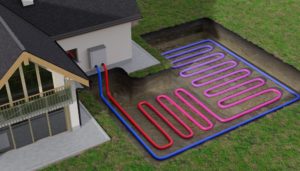
Air Source Heat Pumps
Installation costs: £6,000 to £18,000 depending on the type, requirement, and size.
Such heat pumps are low-carbon and can quickly heat your home. These pumps will absorb the latent heat available in the outside air. Consequently, the device will harness this to increase your home’s temperature.
In most cases, these pumps look similar to an air conditioner. However, their size will determine how much heat gets generated.
Ideally, you will find air-to-air or air-to-water heat pumps in the UK. Not only do air source heat pumps reduce CO2 emissions, but the installation process is less disruptive. Moreover, you should consider these unconventional systems because of the amount of money you will save down the line.
Water Source Heat Pumps
Installation costs: £1,000 to £1,700 for every kW, depending on the type of project – domestic or commercial.
According to Greenmatch, these heat pumps are the best as they get the heat sources from the water underground. It utilises the aquifers to heat your home and water during the winter and keep you cold during the summer. Hence, you get to access stable temperatures and excellent conductivity.
It also reduces the carbon footprint and gives you proper temperatures through energy-efficient methods. This type of heat pump is unique as it absorbs heat from the water loop or rejects the heat in hotter or colder weather.
Compared to other types of heat pumps, this one has a much lessor installation cost and offers reliable performance. It has a quiet HVAC operation and features individual zoning options.
Heat Pump Source: Reliable Heating and Cooling Solutions
At Heat Pump Source, we take pride in our unwavering commitment to serving the UK with top-tier HVAC solutions. From the efficiency of heat pumps and the cool relief of air conditioning to the warmth of boilers, radiators, and underfloor heating, our dedicated team is always at the forefront of innovation. We understand the unique needs of every household and business, and we strive to provide dependable health and cooling products and services that are tailored just for you. Ensuring your comfort and satisfaction is our utmost priority. Whether you have questions, need guidance, or require support, we’re always here to assist. Please don’t hesitate to contact us; we’re eager to be of service.
The Bottom Line
As you can see, these pumps are the best way to move heat to and from your home. Heat pumps are best at generating heat or cold air in the UK. Not only are they energy-efficient but also cost-effective and reliable.
So, have you decided to get these heat pumps installed? Then, it would help if you chose among the different types, namely geothermal, water source, and air source heat pumps.
The workings of any heating system remain the same while the source of heat changes. It works by using compression, condensation, and absorption across all the devices.
Besides, the benefits will also remain similar. For example, you will have less maintenance, low running costs, and better safety. Moreover, it provides proper cooling and heating effects throughout its lifespan.
About the Author
At Heat Pump Source, our articles are the product of a collaborative effort among a team of highly skilled HVAC experts. Our dedicated professionals, hailing from diverse backgrounds in heating, ventilation, air conditioning, and refrigeration, contribute their extensive knowledge and experience to every piece of content. This multidisciplinary approach ensures comprehensive coverage. Our commitment is to deliver authoritative, reliable, and tailored advice to meet the unique needs of every household and business across the UK.

